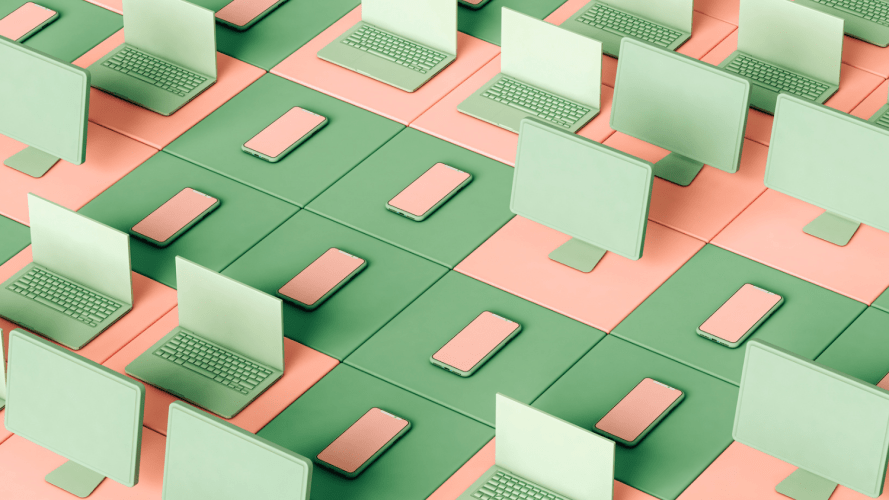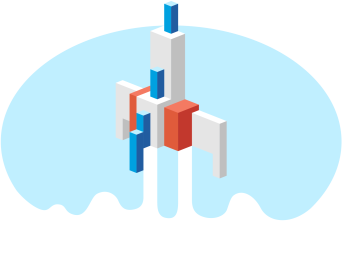Two-thirds of companies report using a design system. Why? Because reusability has big benefits. Restaurants reuse the same ingredient combinations in many dishes. Designers and developers reuse the same components in digital builds. It’s just more effective to reuse what you’ve got. Plus, marketers and IT leaders know the value of giving your customer a cohesive experience.
Discover what a design system is and how it increases cohesion, efficiency, and value.
What you’ll learn
What is a design system?
Cohesive digital interfaces
Efficient product development
Design system value
What is a design system?
For our purposes, a design system is everything a designer and developer need to build cohesive user experiences. Imagine a set of building blocks and an instruction manual. Here’s an example from Slack.

This system includes colors, text size, buttons, icons, and more. Every design system is different. Yet, one aspect they all have in common is components. This is a self-contained block of code that has a specific function. That’s what’s behind everything from the buttons to the icons above.
Everything about a component is standardized and reusable, including:
- What it does
- What it looks like
- How it’s named
- How users interact with it
It’s all detailed in the system’s guidelines that serve as an instruction manual. For Salesforce projects, designers and developers turn to the Salesforce Lightning Design System (SLDS).
Maybe you’re familiar with the standard blue button above. You might’ve seen it on an app home page, a checkout, or even a newsletter subscription. There’s a reason for that. Cohesive designs benefit everyone.
Design Tools
Cohesive digital interfaces
Let’s stick with the blue button. Users know that it will perform a stated action. Part of how they know that is that they’ve seen the same button do it before. Cohesive design builds user habits and expectations.
When users know what to expect, they don’t exert as much mental effort — or “cognitive load” – to complete a task. In short, they do what they need to do, faster.
Now, what if a user came across a yellow button? They might pause or even abandon the experience entirely. Incohesive designs can block people from completing their tasks.
Backend fixes to address these issues require rework. This is also known as technical debt and design debt. Teams can avoid much of it with a design system that maintains cohesion — and speeds up development time, too.
Efficient product development
Creating cohesive designs doesn’t take longer. It’s actually faster when you use a design system. Consider the time it takes a designer to create a button in an error state versus lifting one that exists in their design system. An investigation showed a 34% reduction in hours worked.
That’s just design time. Take it a step further and consider developer time. They don’t have to write that code – or the companion code that guides screen reader software. It’s all in the design system.
With components and other building blocks on hand, designers and developers move quickly. They can repeat and reuse assets. This speeds up product cycles. Who wouldn’t want to cut, say, a six-month cycle down to six weeks? Saving time is saving budget, too.
And that’s just for the initial project. Let’s say there’s an update needed across all buttons. With a design system, it can be updated once and propagated across an app. Even if there are a thousand buttons in that app!
“I expect all designers to bookmark their design system and reference it often,” said Salesforce MVP/Designer Asterisk Loftis. “If not, I worry that they can produce anything of value for a project.”
Championing design efficiency isn’t always easy, but it is effective. Lowering costs helps businesses invest more in innovation and growth.
Design system value
It can be hard to grow with oversized development budgets. Design systems are an effective way to right-size that investment. Then it’s more possible to scale a business to new heights.
Just look at the increased revenue of design-driven companies. Those with high design ratings realized 32% more revenue than counterparts with low design ratings. Additionally, companies that present a consistent brand across platforms achieve 23% higher revenue. Clearly, design has business value.
It all starts with a design system. Ensure designers and developers have everything they need to quickly and successfully build user experiences. Take the first step toward cohesion, efficiency, and value. Learn more about Salesforce Lightning Design System.






























